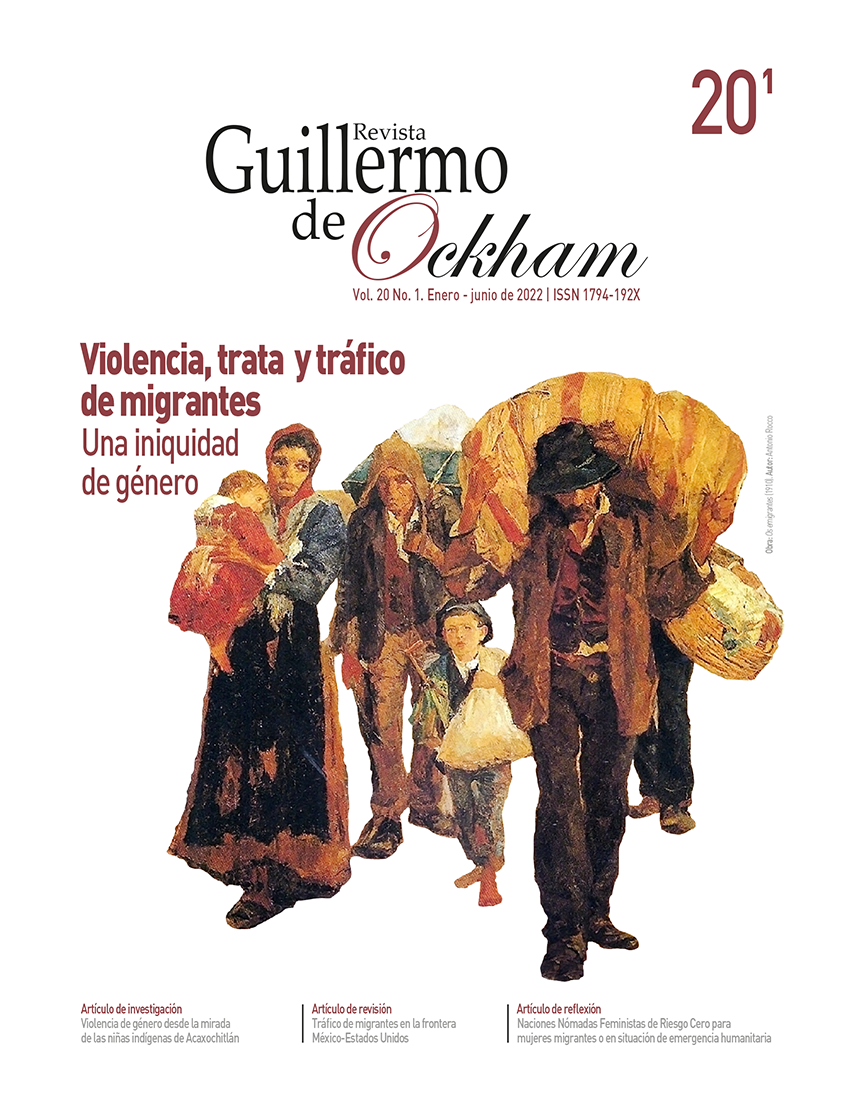The Revista Guillermo de Ockham provides an immediate and open access to its content, based on the principle of offering the public a free access to investigations to provide a global interchange of knowledge.
Unless otherwise established, the contents of this journal has a license with Creative Commons Attribution-NonCommercial-NoDerivatives 4.0 International (CC BY-NC-ND 4.0) http://creativecommons.org/licenses/by-nc-nd/4.0/
- Attribution: You must give appropriate credit, provide a link to the license, and indicate if changes were made. You may do so in any reasonable manner, but not in any way that suggests the licensor endorses you or your use.
- NonCommercial: You may not use the material for commercial purposes.
- NoDerivatives: If you remix, transform, or build upon the material, you may not distribute the modified material.
- No additional restrictions: You may not apply legal terms or technological measures that legally restrict others from doing anything the license permits.
Resumo
El objetivo de este trabajo es identificar e interpretar los elementos que caracterizan la mi- gración forzada vivida por haitianos que llegaron entre 2016 y 2017 a la frontera México-EE. UU., y revisar las oportunidades y los retos más relevantes presentados durante el proceso de espera y apropiación del nuevo espacio. Con base en veinte entrevistas semiestructuradas, se analizaron los relatos de vida en torno a: 1) movilidad y desarraigo y 2) espera y apropiación del nuevo espacio. Se identificaron como causas de los procesos de movilidad forzada haitiana de la última década: la inestabilidad e ingobernabilidad política, la violencia del Estado y de las bandas criminales, la pobreza extrema y los desastres naturales. Asimismo, las experiencias de movilidad forzada desencadenaron estados emocionales como miedo, nostalgia, orgullo y humillación. La espera ha dado sentido no sólo al espacio, sino también a estas personas y a sus grupos de adscripción que se encuentran en esta situación, donde el tiempo ha quedado suspendido, de ahí ha emergido la resignificación de la frontera como territorio de espera. La apropiación de la frontera como nuevo espacio de vida temporal ha tenido importantes implicaciones en las identidades de los inmigrantes haitianos.
Referências
Ariza, M. (2017). Vergüenza, orgullo y humillación: contrapuntos emocionales en la experiencia de la migración laboral femenina. Estudios Sociológicos, 35 (103), pp. 65-89. https://doi.org/10.24201/es.2017v35n103.1510.
Augé, M. (2008). Los no lugares. Gedisa.
Bartram, David (2015). Forced Migration and “Rejected Alternatives”: A Conceptual Refine- ment, Journal of Immigrant & Refugee Studies, 13(4), pp. 439-456, DOI:10.1080/15562948.2 015.1030489
Belford, N., & Lahiri-Roy, R. (2019). (Re)negotiating transnational identities: notions of ‘home’ and ‘distanced intimacies’. Emotion, Space and Society, 31, pp. 63-70. https://doi.org/10.1016/j. emospa.2018.11.004
Coraza de los Santos, Enrique. (2020). ¿De qué hablamos cuando nos referimos a las movilidades forzadas? Una reflexión desde la realidad latinoamericana. Estudios Políticos (Universidad de Antioquia), 57, pp. 128-148. DOI:10.17533/udea.espo.n57a07
Coulter, C. A. & Smith, M. L. (2009). The construction zone: Literary elements in narrative research. Educational Researcher 38(8). pp. 577-590.
Delgado, J. & Gutiérrez, J. (Coord.) (2007). Métodos y técnicas cualitativas de investigación en ciencias sociales. Síntesis Psicología.
Garbey-Burey, R. (2017). Estrategias migratorias en el tránsito de emigrantes haitianos hacia Estados Unidos. Huellas de la migración, 2(4). pp. 93-123.
Gustafson, P. (2009). Mobility and territorial belonging. Environment and behavior 41(4), pp. 490-508. 10.1177/0013916508314478
International Organization for Migration OIM (2019). Glossary on migration (Publication No. 34). International Migration Law. https://www.iom.int/news/iom-releases-glossary-migration-foster-correct-use-migration-terminology
Krippendorf, K. (2018). Content analysis: An introduction to its methodology. Sage.
Lewicka, M. (2008). Place attachment, place identity, and place memory: Restoring the forgotten city past. Journal of Environmental Psychology, 28(3) pp. 209-231. https://doi.org/10.1016/j. jenvp.2008.02.001
López, E.A., Juárez, L. G. & Veytia, M.G. (2019). Esquema tipológico de las migraciones y desplazamientos forzados [Typological scheme of migrations and forced displacements]. Estudios Fronterizos, 20, e028. https://doi.org/10.21670/ref.1907028
Louidor, W. E. (2016). Articulaciones del desarraigo en América Latina. El drama de los sin hogar y sin mundo. Pontificia Universidad Javeriana.
Louidor, W. E. (2020). Trazos y trazas de la migración haitiana post-terremoto. Política Globalidad y Ciudadanía, 50-72. https://doi.org/10.29105/pgc6. pp. 11-3
Méndez, H. & Reyes, E.P. (2021). Miedo a los otros. Representaciones de la frontera México-Estados Unidos y COVID-19 en medios digitales. Estudios Fronterizos, 22 (e064) https://doi. org/10.2167/ref.2101064
Mezzadra, S. & Neilson, B. (2017). La frontera como método. Ed. Traficantes de sueños.
Montoya-Ortiz, M., & Sandoval-Forero, E. (2018). Migrantes haitianos en México: un nuevo escenario migratorio. Huellas de la migración, 3(6), pp. 133-156.
Musset, A. (2015). De los lugares de espera a los territorios de la espera. ¿Una nueva dimensión de la geografía social? Documents d’Anàlisi Geogràfica 61 (2), pp. 305-324. http://dx.doi.org/10.5565/rev/dag.315
Neuendorf, K. (2017). The Content Analysis Guidebook. Los Ángeles: Ed. Sage.
París, M.D. (2018). Migrantes haitianos y centroamericanos en Tijuana, Baja California, 2016-2017. Políticas gubernamentales y acciones de la sociedad civil. Comisión Nacional de Derechos Humanos y El Colegio de la Frontera Norte.
Peng, J., Strijker, D., & Wu, Q. (2020). Place Identity: How Far Have We Come in Exploring Its Meanings? In Frontiers in Psychology (Vol. 11). Frontiers Media S.A. https://doi.org/10.3389/ fpsyg.2020.00294
Piñuel, J. (2002). Epistemología, metodología y técnicas del análisis del contenido. Estudios de sociolingüística, 3(1). pp. 1-42.
Proshansky, H.M. (1978). Proshansky1978.pdf. In Environment and Behavior. pp. 147-169.
Ramírez, K. (2020). El camino hacia la integración de los migrantes haitianos en Mexicali en Reyes, M. (Coord.). Multiculturalismo e integración: La migración haitiana en Baja California. Universidad Autónoma de Baja California.
Svasek, Maruska (2002). Narratives of “Home” and “Homeland”: The Symbolic Construction and Appropriation of the Sudeten German Heimat, Identities: Global Studies in Culture and Power, 9:4. pp. 495-518, DOI: 10.1080/10702890214871
Svasek, Maruska (2010). On the Move: Emotions and Human Mobility, Journal of Ethnic and Migration Studies, 36:6. pp. 865-880, DOI: 10.1080/13691831003643322
Taylor, S. y Bogdan, R. (1987). Introducción a los métodos cualitativos de investigación. Ed. Paidós Básica.
Thomaz, Diana, (2013). La migración haitiana tras la catástrofe. En Revista de Migraciones Fronterizas (43). pp. 35-36.
Vidal, T., & Pol, E. (2005). La apropiación del espacio: una propuesta teórica para comprender la vin- culación entre las personas y los lugares. Anuario de Psicología, 36 (3). pp. 281-297.
Wise, Amanda & Velayutham, Selvaraj (2017). Transnational Affect and Emotion in Migration Research, International Journal of Sociology, 47:2, pp. 116-130, DOI:10.1080/00207659.2017.1300468

 Perfil Google Scholar
Perfil Google Scholar






























